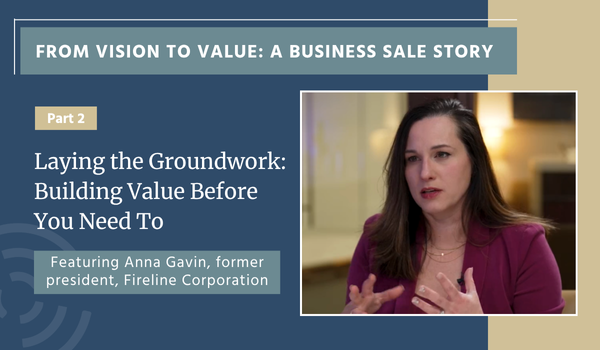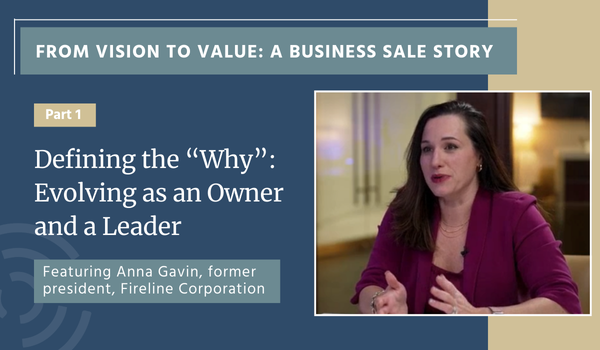Originally published in CityBizList, July 14, 2011
Written by: Newt Fowler
Lots of attention is given to certain aspects of how to sell a business, from due diligence to negotiation strategies. Less is given to how to prepare for the emotional rollercoaster a CEO faces when selling a company. So I recently sat down with Charlie Maskell, Managing Member of Chesapeake Corporate Advisors, over lunch to explore the emotional dynamics that come with selling a business.
 The Skinny Chesapeake Corporate Advisors advises owners and investors in middle market businesses, Charlie Maskell leading clients on the journey to measure (valuation), create (strategy) and realize (M&A) shareholder value. It uses methodologies rooted in experience, creativity and comprehensive data analysis to provide these services
The Skinny Chesapeake Corporate Advisors advises owners and investors in middle market businesses, Charlie Maskell leading clients on the journey to measure (valuation), create (strategy) and realize (M&A) shareholder value. It uses methodologies rooted in experience, creativity and comprehensive data analysis to provide these services
The Missing Conversation Neither Charlie nor I wanted to spend our time talking about the due diligence or negotiation process. These are transaction “chestnuts” that fail to highlight some of the more critical dynamics facing a selling CEO. I really wanted Charlie’s perspective on the seller’s mindset, both the pitfalls he has seen and the best emotional perspective in which to take on a potential sale of a business. Charlie’s overarching advice was clear enough “don’t become a seller until the wire hits.”
Emotional Stages in a Sale Charlie explored four fairly predictable emotional stages that any entrepreneur goes through during the sale process:
First, Anxiety: which manifests itself in worrying about how the sale process works; how to disclose the impending sale to customers, employees and competitors; about valuation.
Second, Euphoria: usually achieved when the letter of intent is signed; according to Charlie, this is usually the emotional high water mark in the deal; it generally runs downhill from here until the wire clears.
Third, Fatigue: the grinding process of due diligence, negotiations, documentation, gathering buy-in, all with the general effect of killing off the entrepreneurial spirit of the seller; fatigue hits is nadir, according to Charlie, when the CEO keeps saying “just get it done”.
Fourth, Relief: manifested when either the deal is done or is dead.
Setting the Stage So if these are the inevitable (and predictable) emotional stages an entrepreneur will go through as he sells his company, I asked Charlie how one gets a seller into the right emotional frame of mind to complete the sale process with as little trauma as possible. Charlie suggests that there are three touchstones every entrepreneur must understand in order to be emotionally prepared to sell:
First, one must have a reasonable expectation regarding the value of the business and early on that expectation needs to be tested to ensure alignment with the prospective buyer; in other words, a seller shouldn’t simply wait to decide whether he likes a buyer’s price.
Second, one must begin to understand the fundamental change such a sale will have in their life; once the sale process is completed, one gives up control, leaves the role as CEO, upends daily routines; this (‘reset” becomes even more profound if there is a residual role after closing, placing the entrepreneur in a sort of leadership netherworld.
Third, an entrepreneur must understand how the sale proceeds after taxes affects their financial goals; does the transaction achieve financial independence or does it lead to another career or company? This understanding dearly affects the timing for a sale and also such matters as restrictive covenants (non-competes) and residual roles and continuing compensation; in Charlie’s mind, thinking about the next stage is a critical component before pursuing the sale process,
Balancing Act Charlie sees the sale process for an entrepreneur “as a balancing process, an effort to reach equilibrium”. It requires “managing the sale efforts, while running the business, while all the time, retaining the mindset that you’re not a seller.” One of the keys in such a high wire act, for Charlie, is “having good and well coordinated teams, both a deal team and an operational team.” Such coordination “allows a CEO to leverage so you’re not trapped in two worlds.” This balancing process has another dynamic for Charlie, in what types of issues should the CEO playing a leading role. “Positive, momentum building issues should be handled by the CEO, while negative, divisive issues should be handled by the deal team.”
Communication 101 The CEO, Charlie urges, “must have the confidence to include management in the [sale] process to avoid both overload and a single point of failure.” “Delaying this awareness,” Charlie warns, “complicates the deal.” This process of Including and involving management is more nuanced than simply assigning tasks. “Clarity in what is transpiring reduces friction and uncertainty.” Not only does it stabilize the emotional dynamics everyone in an organization feels, but it also makes the deal easier to execute.
Run Away. As we finished our lunch, I asked Charlie what were the most common buyer personalities that he most frequently saw causing deals to go awry. He suggested two types of problematic buyers, and that if either appeared, the entrepreneur should seriously reconsider whether the sale process would be a waste of time. First, an overly aggressive buyer (works for investor too). If re-trades, hostile conversations and destructive behavior happen early, “you either need alignment quickly, or don’t waste your time.” In Charlie’s experience, this aggressive behavior rarely improves. Second, the casual buyer, who is merely testing the water. “They either aren’t serious, don’t like the process or aren’t prepared to buy.” “Some buyers,” Charlie mused, “may not be worth it.
The Take Away Lots of energy is expended on core transactional issues, on due diligence, and on negotiation dynamics; and while these are important to getting a deal done, the emotional undercurrent is often addressed as triage, after it has affected the deal. It makes little sense to allow the understandable emotional response of a CEO (or of his team) impede the deal or to leave the CEO unprepared for what lies beyond the closing. I share Charlie’s view that ensuring the CEO is prepared for the impending roller coaster the he and his employees are about to endure is central to ensuring an inevitably trying process doesn’t fail for the wrong reasons. The passion of the CEO that got the company to this liquidity event shouldn’t become the seeds of its undoing.




